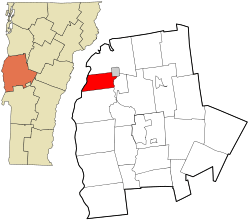Panton, Vermont facts for kids
Quick facts for kids
Panton, Vermont
|
||
|---|---|---|
 |
||
|
||

Location in Addison County and the state of Vermont.
|
||
| Country | United States | |
| State | Vermont | |
| County | Addison | |
| Area | ||
| • Total | 22.0 sq mi (57.1 km2) | |
| • Land | 15.5 sq mi (40.2 km2) | |
| • Water | 6.6 sq mi (17.0 km2) | |
| Elevation | 259 ft (79 m) | |
| Population
(2020)
|
||
| • Total | 646 | |
| • Density | 42/sq mi (16.1/km2) | |
| Time zone | UTC-5 (Eastern (EST)) | |
| • Summer (DST) | UTC-4 (EDT) | |
| ZIP code |
05491
|
|
| Area code | 802 | |
| FIPS code | 50-53950 | |
| GNIS feature ID | 1462169 | |
Panton is a small town in Addison County, Vermont, United States. It's home to 646 people, according to the 2020 census.
Geography of Panton
Panton is located in the northwestern part of Addison County. It sits right along the border between New York and Vermont.
A big part of Panton's western side reaches into Lake Champlain. A wide waterway called Dead Creek flows through the town from south to north. Otter Creek forms most of the town's eastern edge.
Panton is surrounded by other towns. To the north is Ferrisburgh, and to the northeast is Vergennes. Waltham is to the east, and Addison is to the south. Across Lake Champlain, which is about 2 miles (3.2 km) wide here, is the town of Westport, New York.
The total area of Panton is about 22 square miles (57.1 square kilometers). About 15.5 square miles (40.2 square kilometers) is land, and 6.6 square miles (17.0 square kilometers) is water. That means almost 30% of Panton is water!
Like much of the Champlain Valley, Panton has flat land. This makes it great for farming. For hundreds of years, people in Panton have used a special local stone called Panton Stone for building. This stone comes from the Ordovician Crown Point Formation. If you look closely at Panton Stone, you might even find fossils of ancient sea creatures!
Panton's Population Over Time
| Historical population | |||
|---|---|---|---|
| Census | Pop. | %± | |
| 1790 | 220 | — | |
| 1800 | 363 | 65.0% | |
| 1810 | 520 | 43.3% | |
| 1820 | 546 | 5.0% | |
| 1830 | 605 | 10.8% | |
| 1840 | 670 | 10.7% | |
| 1850 | 559 | −16.6% | |
| 1860 | 511 | −8.6% | |
| 1870 | 390 | −23.7% | |
| 1880 | 419 | 7.4% | |
| 1890 | 382 | −8.8% | |
| 1900 | 409 | 7.1% | |
| 1910 | 345 | −15.6% | |
| 1920 | 321 | −7.0% | |
| 1930 | 306 | −4.7% | |
| 1940 | 312 | 2.0% | |
| 1950 | 332 | 6.4% | |
| 1960 | 352 | 6.0% | |
| 1970 | 416 | 18.2% | |
| 1980 | 537 | 29.1% | |
| 1990 | 606 | 12.8% | |
| 2000 | 682 | 12.5% | |
| 2010 | 677 | −0.7% | |
| 2020 | 646 | −4.6% | |
| U.S. Decennial Census | |||
In the year 2000, there were 682 people living in Panton. These people lived in 248 households, and 192 of those were families. The town had about 44 people per square mile.
About 33% of the households had children under 18 living there. Most households (68%) were married couples. About 16% of households were people living alone. The average household had about 2.75 people.
The population's age spread showed that about 25% were under 18 years old. About 13.6% were 65 or older. The average age in Panton was 41 years old.
History of Panton
Panton played a small but important role in the American Revolutionary War. After the Battle of Valcour Island, which was one of the first naval battles of the war, American General Benedict Arnold had to retreat.
He ordered his five ships to go into Ferris Bay in Panton. This bay is now called Arnold's Bay. The water there was too shallow for the bigger British ships to follow. Arnold's men took everything useful off their boats. Then, they set the ships on fire, leaving their flags still flying.
General Arnold was the last person to leave. He personally set fire to his own main ship, the Congress. This event helped the Americans escape from the British forces.
See also

- In Spanish: Panton (Vermont) para niños


